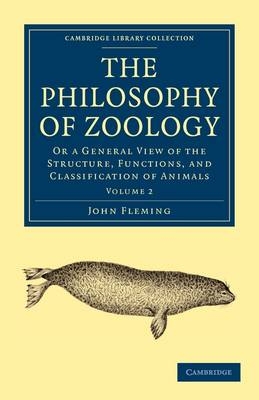
The Philosophy of Zoology
Or a General View of the Structure, Functions, and Classification of Animals
Seiten
2009
Cambridge University Press (Verlag)
978-1-108-00166-3 (ISBN)
Cambridge University Press (Verlag)
978-1-108-00166-3 (ISBN)
John Fleming (1785–1857) was a minister of the Church of Scotland, but in his time at the University of Edinburgh he had also studied geology and zoology. His two-volume Philosophy of Zoology published in 1822, was borrowed by the young Charles Darwin from Edinburgh University Library.
John Fleming (1785–1857) was a minister of the Church of Scotland, but in his time at the University of Edinburgh he had also studied geology and zoology. In the tradition of the country parson who was also a talented and knowledgeable naturalist, he published his first works on the geology of the Shetland Islands while serving there as a minister. His subsequent works led to his being offered the chair of natural philosophy at the University of Aberdeen, and subsequently at the newly created chair of natural history at the Free Church College in Edinburgh. The two-volume Philosophy of Zoology was published in 1822, and the young Charles Darwin is recorded as borrowing it from the library of Edinburgh University in 1825/6. His intention in the book was to 'collect the truths of Zoology within a small compass, and to render them more intelligible, by a systematical arrangement'.
John Fleming (1785–1857) was a minister of the Church of Scotland, but in his time at the University of Edinburgh he had also studied geology and zoology. In the tradition of the country parson who was also a talented and knowledgeable naturalist, he published his first works on the geology of the Shetland Islands while serving there as a minister. His subsequent works led to his being offered the chair of natural philosophy at the University of Aberdeen, and subsequently at the newly created chair of natural history at the Free Church College in Edinburgh. The two-volume Philosophy of Zoology was published in 1822, and the young Charles Darwin is recorded as borrowing it from the library of Edinburgh University in 1825/6. His intention in the book was to 'collect the truths of Zoology within a small compass, and to render them more intelligible, by a systematical arrangement'.
1. On the condition of animals; 2. On the methods of investigation employed; 3. On the rules of nomenclature; 4. General view of the classification of the objects of the animal kingdom.
| Erscheint lt. Verlag | 20.7.2009 |
|---|---|
| Reihe/Serie | Cambridge Library Collection - Zoology ; Volume 2 |
| Zusatzinfo | Worked examples or Exercises |
| Verlagsort | Cambridge |
| Sprache | englisch |
| Maße | 35 x 216 mm |
| Gewicht | 790 g |
| Themenwelt | Geschichte ► Teilgebiete der Geschichte ► Technikgeschichte |
| ISBN-10 | 1-108-00166-1 / 1108001661 |
| ISBN-13 | 978-1-108-00166-3 / 9781108001663 |
| Zustand | Neuware |
| Haben Sie eine Frage zum Produkt? |
Mehr entdecken
aus dem Bereich
aus dem Bereich
Buch | Softcover (2024)
Lehmanns Media (Verlag)
19,95 €
Digitalisierung neu denken für eine gerechte Gesellschaft
Buch | Hardcover (2023)
Quadriga (Verlag)
20,00 €
Vom Perceptron zum Deep Learning
Buch | Softcover (2022)
Springer Vieweg (Verlag)
19,99 €


